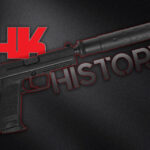
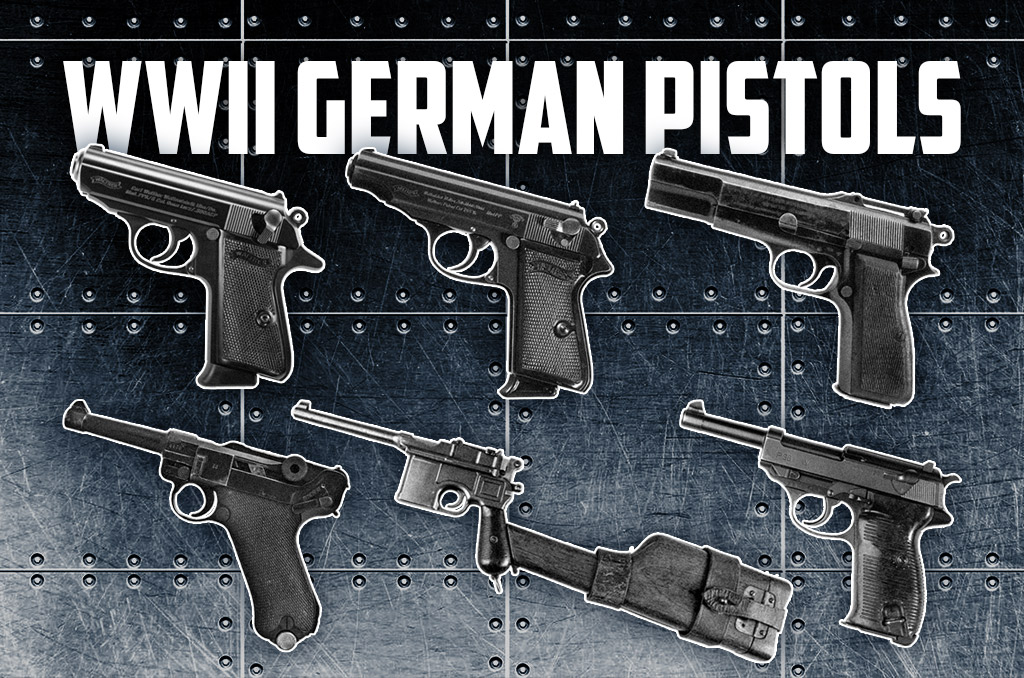
As World War II began in 1939, Germany amassed the most powerful and organized fighting force the modern world had ever seen. With one hundred infantry and six armored divisions, they were well equipped for the blitzkrieg (lightning war) that would overwhelm Europe and move through Russia a year later. Which WWII German pistols played a role in the blitzkrieg? We’ll take a look below.
Much has been written on the armaments that comprised a standard German division. The standard was 442 machine guns, 135 mortars, 72 antitank guns, and 24 howitzers. Also well documented were the armored, or panzer, divisions with a total of 2,400 tanks—a number that would grow during the early years of the war.
However, amid all the shock and awe provided by the Wehrmacht’s big guns, the German pistol is often relegated to a secondary, less important role in the campaign. Still, Germany manufactured some of the best handguns of the war, and they merit a discussion every bit as much as the MG-34 machine gun and the StG 44 assault rifle.
Here are six classic German pistols from World War II:
Walther P38

Carl Walther developed the Walther P38 as a service pistol for the Wehrmacht at the beginning of World War II.
Although the arms manufacturer Carl Walther Waffenfabrik began testing the P38 in 1938, it wasn’t mass-produced until 1940. The P38 was a replacement for the more expensive Luger P08. Hard to believe, but each Luger cost $19.80 to produce, while the P38 was $14.08. The 9mm semi-automatic Walther P38 pistol became the service pistol of the Wehrmacht around that time.
The P38 fired the standard 9x19mm Parabellum cartridge at 1200 ft/second. It was the first locked-breech pistol with a double-action/single-action trigger. The P38 had an 8-round detachable magazine and rear notch and front blade post sights. While the original pistols were fitted with walnut grips, they were replaced with Bakelite later in the war.
During the frigid winters on the Russian front, gun lubricants froze and jammed the semi-automatic weapons. German soldiers removed the oil from the moving parts, and by all accounts, the P38 performed flawlessly.
Luger P08
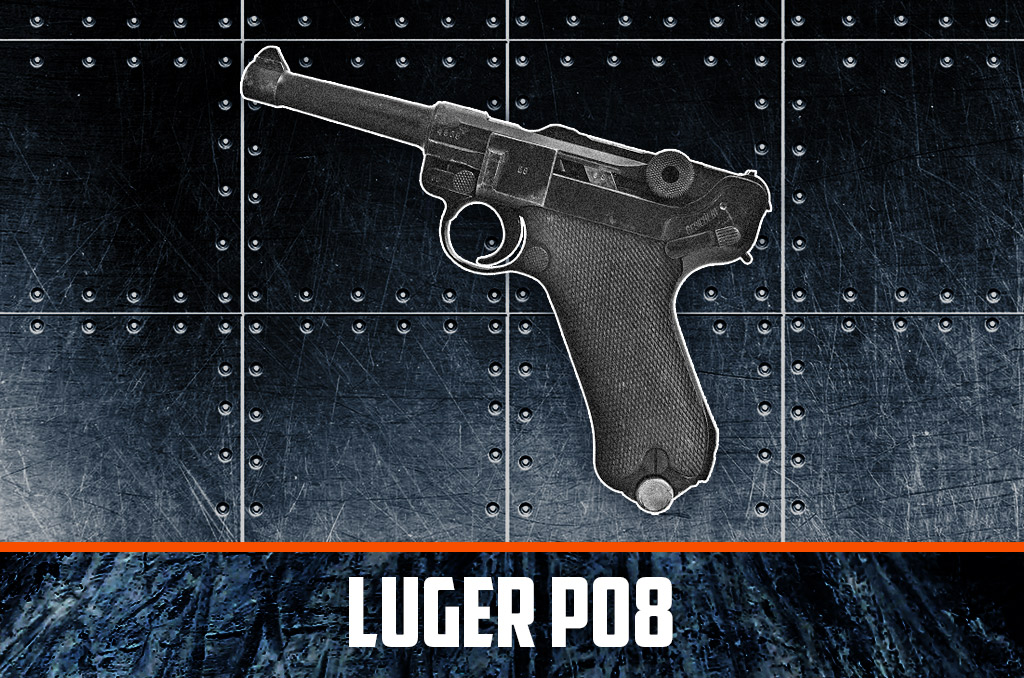
The Luger pistol was widely used by Germany during World War I and World War II.
George Luger designed the iconic P08 in 1898, and the German Army adopted it as their standard sidearm in 1908. It would go on to see action in two world wars. Originally produced to chamber a 7.65mm round, the Luger became the first pistol to use the 9x19mm Parabellum round. The 9mm cartridge has since become one of the world’s most popular cartridges.
Even though the Walther P38 would replace the semi-automatic toggle-locked pistol at the start of World War II, it was not because of reliability issues. Instead, the P08 was deemed too slow and expensive to make. However, it remained in production until 1943 and would see widespread use until the war ended in 1945.
Most estimates indicate that around two million Lugers were manufactured over forty-plus years of production. Captured Lugers became prized souvenirs for Allied soldiers. They were sought after during both world wars, and it is still one of the most collected military pistols today.
Walther PP

The PP and the PPK series pistols were among the world’s first double-action semi-automatic handguns.
The Walther PP (Polizei Pistole, or Police Pistol) was introduced in 1929 and became the world’s first commercially successful double-action semi-automatic pistol. Manufactured by the Carl Walther GmbH company, the PP initially became the weapon of choice of law enforcement and paramilitary groups. Later, it was issued to the military, with the Schutzstaffel (SS), Luftwaffe (Air Force), Panzer tank crews, and Nazi party officials carrying the reliable and concealable pistol.
The PP was initially chambered for the 7.65x17mm Browning SR (.32 ACP), but later models used .22 Long Rifle ammo, 9x17mm Short (.380 ACP), 6.35x15mm Browning SR (.25 ACP), and the 9x18mm Ultra. To fire these rounds, the user pulls through a long and heavy trigger pull. However, after the first shot, the hammer is cocked, the trigger is near the rear of the trigger guard, and the PP is ready for the next single-action shot.
WWII German Pistols: Walther PPK

A favorite of fictitious spies and real-life tyrants, the Walther PPK has earned a well-deserved place in history.
Fans of Ian Fleming’s series of James Bond books and movies should be familiar with the Walther PPK. It’s the pistol that the Agent 007 superspy often carried. Brought out just two years after the PP, the PPK (Polizeipistole Kriminal, referring to the German crime investigation office) was a smaller version of the PP with a shorter barrel and frame, making it even more concealable than its predecessor.
German military officers and members of the infamous Gestapo carried the PPK throughout World War II. Near the end of the war, Adolph Hitler used the model to end his life in his Berlin bunker. Even 75 years after Hitler’s death, the superbly designed PPK remains one of the most sought-after concealed carry pistols.
Browning Hi-Power
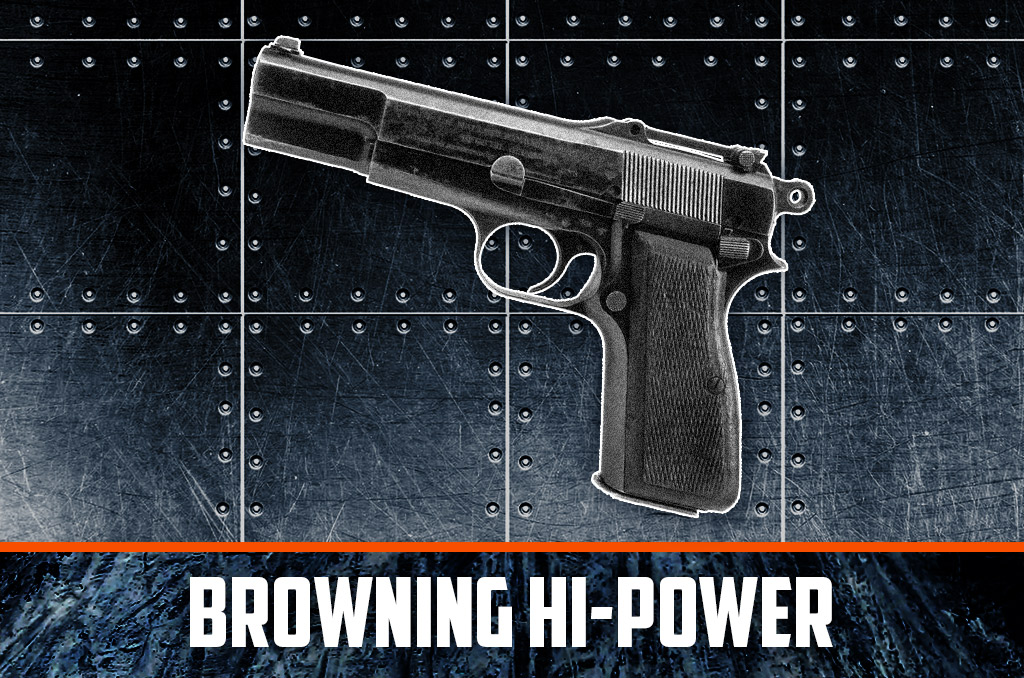
The legendary Browning Hi-Power can actually be found chambered in three calibers: 9x19mm, .40 S&W, and 7.65×21.
John Browning began building the Hi-Power using his Colt M1911 design as a starting point. When Browning died in 1926 before completing it, his protégé Dieudonné Saive finished it on behalf of the Belgian arms maker Fabrique Nationale (FN). When the Germans captured Belgium in 1940, FN had produced 56,000 pistols. The invaders forced the Belgians to keep manufacturing the Hi-Power and handed many of them out to the Waffen SS and Fallschirmjagers, the elite paratroopers in the Luftwaffe.
Throughout World War II, both sides used the 9mm Browning Hi-Power single-action semi-automatic pistols. The Germans produced the guns at the FN plant in occupied Belgium. The Allies produced their versions by John Inglis and Company in Canada. Even after World War II, the Hi-Power continued to be one of the most widely used military pistols.
Mauser C96
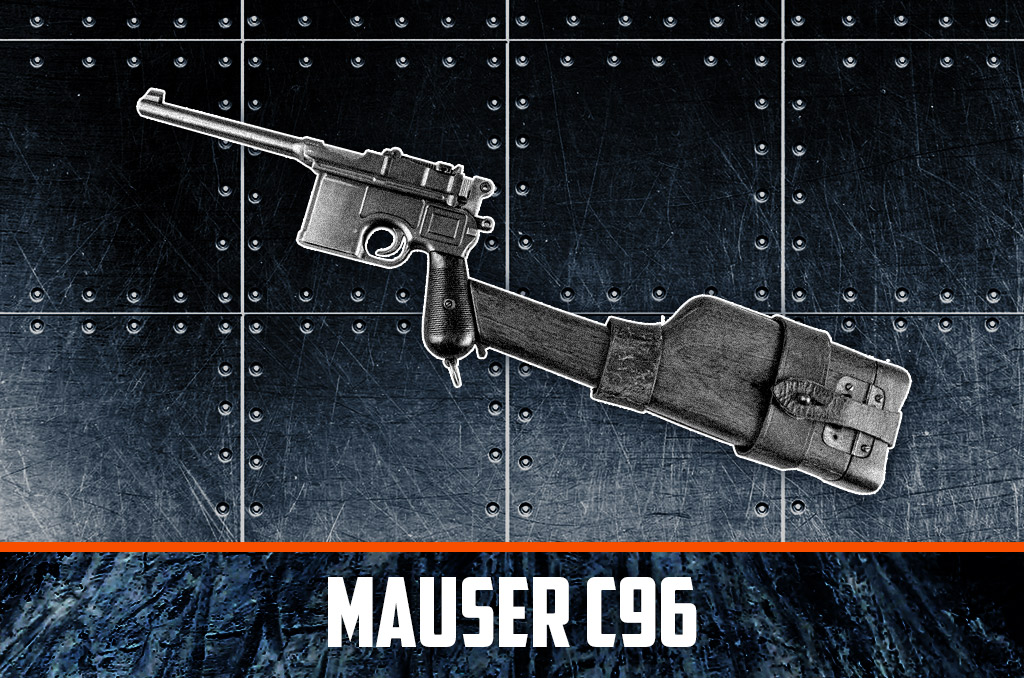
Different variations of the Mauser C96 have been used in film and television productions, as well as in popular video games.
The Mauser C96 is a semi-automatic pistol built by the German arms manufacturer Mauser from 1896 until 1937. Although it saw extensive service during World War I, some Mausers were distributed to the Luftwaffe, Waffen SS, Kriegsmarine (Navy), and other organizations in the Second World War.
The Mauser’s 7.63mm cartridge provided a high-speed projectile that caused substantial damage, even over longer distances. But it was the gun’s distinctive features that garnered much of the attention:
- A “broom handle” grip (Its nickname was Broomhandle)
- Its 5.5” long barrel
- An integral box magazine in front of the trigger
- A wooden shoulder stock doubling as a holster or carrying case
Because of its unique look, the C96 made appearances in several James Bond films. Later, it was famously modified to become Han Solo’s blaster pistol in the Star Wars series.
WWII German Pistols: Legendary Sidearms
For many vintage weapon collectors, the pits, scratches, and scars tell the real story. They prefer weapons that have seen battle, rather than those stored in a safe their entire lives. When it comes to WWII German pistols, collectors have a respectable selection of weapons to choose from. Many bearing markings from their time in service with the Third Reich.
For the allied soldiers in the war, many WWII German pistols became war trophies. Many of the recovered pistols were taken directly off of captured German soldiers, then brought home in duffel bags. Some have service papers and specific provenance, while others are wrapped up in legends that get bigger as the years go by. One thing is for sure, their popularity with collectors shows no signs of slowing down.


